Summary
- The market offers a wide variety of colors, textures, prints, and fabric sizes
- Using a fabric composition chart can help minimize errors in production
- Want fresh fashion news straight to your inbox? Subscribe to our newsletter!
If you are involved in apparel manufacturing, it’s crucial to understand the diverse range of fabrics available. Each type of fabric has its own combination of colors, textures, prints, sizes, composition, and nomenclature.
That’s why using a fabric composition table is invaluable when creating a garment from scratch. By aligning your product concept with the attributes of a specific fabric, you reduce the risk of rework and resource waste.
To make this process easier, we have prepared a fabric composition list with the most common materials in the apparel industry. This resource helps you make informed decisions during collection development, improving both precision and efficiency.
Eager to delve deeper into this topic? Keep reading for valuable insights!
Sumário
Why is a fabric composition chart important?
A fabric composition chart is a key tool in apparel production. It shows the fibers and blends in each fabric, helping you choose the right material for your designs. This ensures the garment’s look, feel, and performance match your goals.
It also helps avoid costly mistakes. By checking the chart before production, you can prevent issues like shrinkage, stretching, or fading, saving time and resources.
In addition, it improves communication with suppliers and customers. Knowing a fabric’s makeup lets you provide accurate details, build trust, and maintain your brand’s credibility.
Fabric composition chart for fashion professionals
The fabric composition chart helps to mitigate production errors and enhance the ultimate quality of your apparel, also contributing to a textile industry that prioritizes high standard parameters.
Fabric compositions typically encompass synthetic, natural, or artificial fibers. Vigilance toward the manufacturer’s label is imperative, as it reveals any thread amalgamation woven into the fabric.
Take a closer look at the various fabric types and their compositions below.
Important note: the fabric compositions listed here are approximate reference values, sourced from fabric tables of various manufacturers. These values may differ across countries and even among different manufacturers.
Broderie anglaise
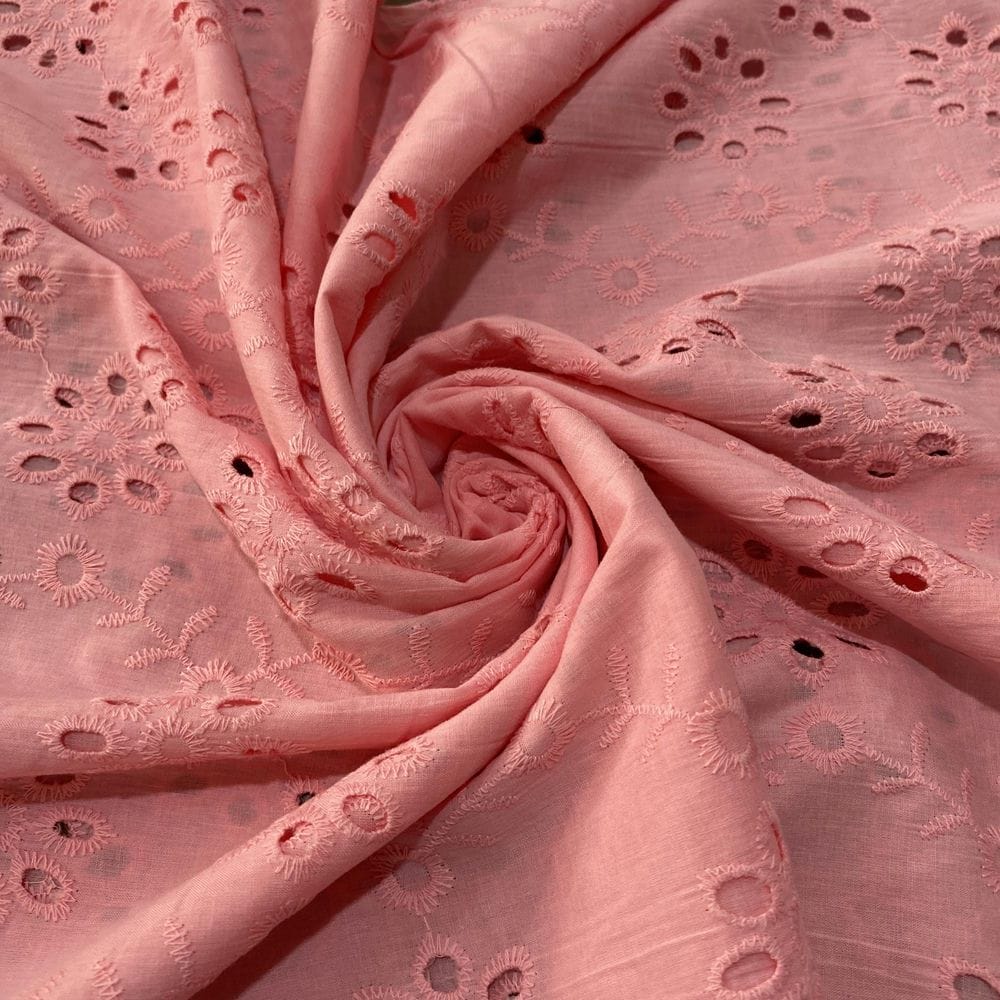
A fabric extensively favored during hot seasons, the broderie anglaise is crafted from cotton and adorned with perforations. These apertures offer an ideal canvas for a diverse range of embroideries, spanning from delicate florals to intricate geometric motifs.
- Borderie Anglaise Pure Cotton: 100% Cotton
- Borderia Angalise with Eyelets: 65% Polyester / 35% Cotton
Learn more: 9 fabrics with the perfect fit to use in your fashion collection
Chiffon
Versatile and wrinkle-resistant, chiffon boasts an excellent drape, making it a popular choice for party attire as well as other clothing items.
Its distinctive feature lies in its inherent translucency, accompanied by a subtle tactile coarseness and an uneven surface. These characteristics lend its fibers a unique texture.
- Jacquard Chiffon: 100% Polyester
- Pearl Chiffon: 100% Polyester
- Silk Crepe Chiffon: 100% Silk
- Chiffon with Lurex: 98% Polyester / 2% Lurex
- Chiffon with Lurex and Silk: 41% Cotton / 38% Viscose / 19% Silk / 1% Polyamide / 1% Polyester
Cotton
The most widely used textile fiber in the world, Cotton stands as a hypoallergenic fabric, making it a top contender for form-fitting attire.
Its natural properties afford wearers a comfortable thermal experience, rendering it a popular choice for a variety of clothing items such as t-shirts, undergarments, and other intimate wear.
- Organic Cotton: 100% Organic Cotton
- Jersey: This isn’t always made of 100% cotton. Typically made from silk, cotton, or synthetic fibers like viscose and polyester
- Muslin: 100% Cotton (But certain forms can also incorporate silk and viscose)
- Cambric: 100% Cotton
- Calico: 100% Cotton
Cotton Pique
Cotton Pique is a textile chosen for crafting sportswear, characterized by distinctive geometric patterns. It can be fashioned from pure cotton or blended with polyester.
- Double Pique: 100% Polyester
- Micro Pique: 100% Cotton
- Swiss Pique: 100% Pure Cotton
- Mixed Pique: 33% Cotton / 67% Polyester
- Pure Cotton Pique: 100% Cotton
Crepe
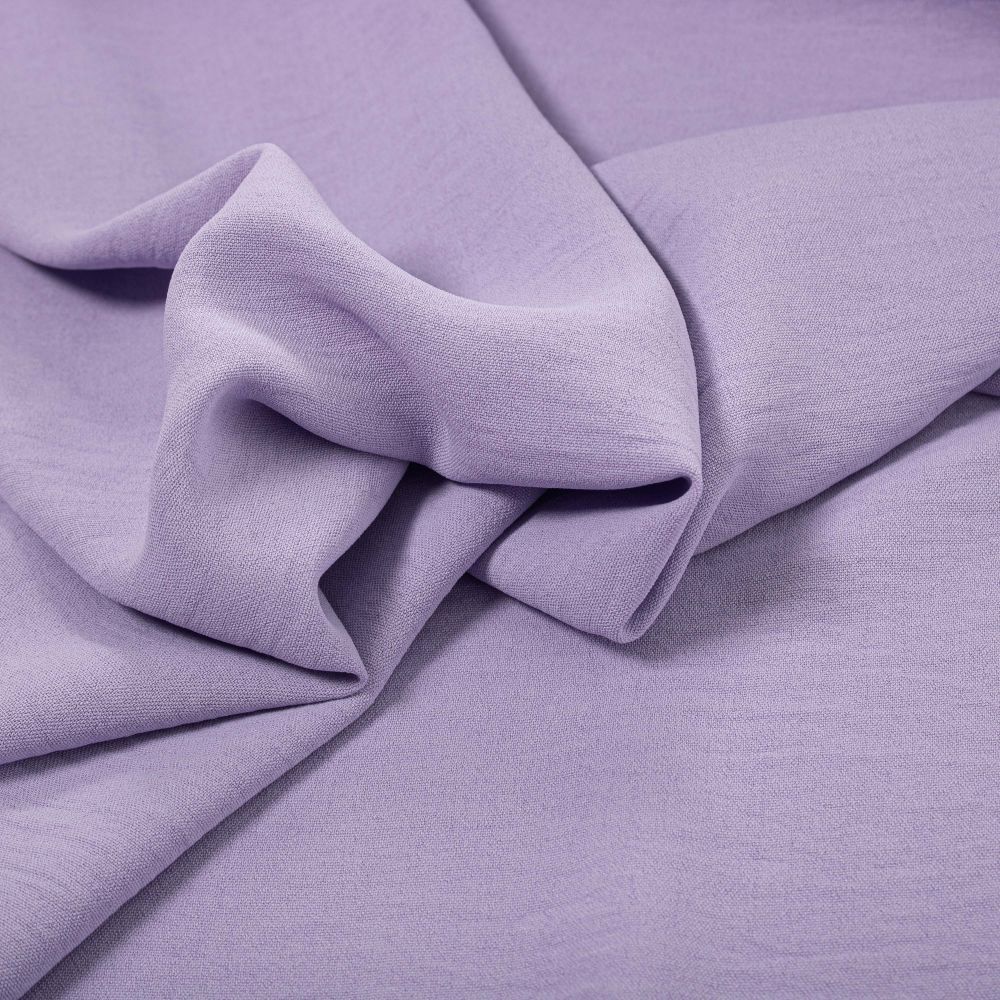
Crepe fabric offers an array of textures, spanning from a subtly textured crepe to the silkiest, most even surfaces.
This versatility renders it suitable for an array of applications, encompassing both formal and relaxed attire, in addition to decorative and upholstery purposes.
Furthermore, its lightweight and fluid nature ensures comfortable wear, making it an optimal choice for clothing.
- Crepe de Chine: 100% Silk
- Georgette Crepe: 100% Polyester
- Crepe Georgette Silk: 100% Silk
- Matte Crepe: Polyester, Rayon, or a blend
- Wool Crepe: Can be 60% Wool / 38% Rayon / 2% Lycra
- Polyester Crepe: 100% Polyester
- Canton Crepe: Can be made from various natural or synthetic fibers, such as Silk, Wool, Cotton, Rayon, Polyester, or Nylon
Learn more: Learn more about crepe fabric and its various uses in fashion
Denim
Renowned for its durability and exceptional comfort, denim has become a staple in various applications, notably uniform production. This versatile fabric boasts several primary types:
- Raw Denim: 100% Cotton
- Pelleted Denim: 100% Cotton
- Professional Twill Denim: 100% Cotton
Flannel
Flannel, a fabric known for its warmth, comfort, and softness, finds its niche primarily in colder seasons, offering a crucial contribution to maintaining thermal equilibrium.
It is notably favored for crafting garments like pajamas and shirts.
- Flannel: 100% Cotton or 50/50 blend of Cotton and Wool
Gabardine
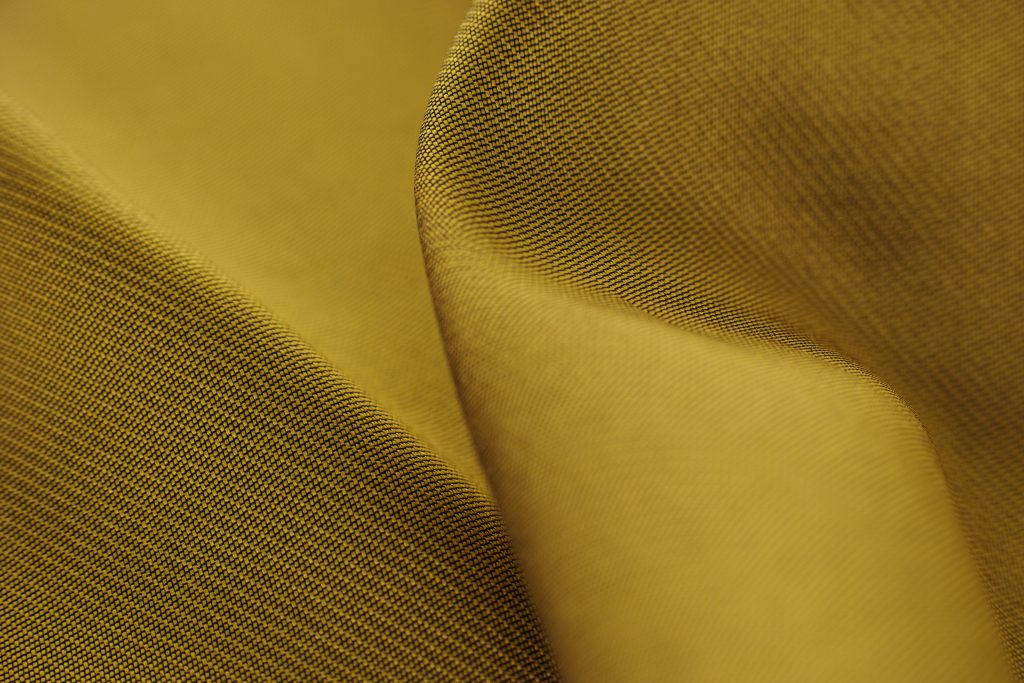
Gabardine, a fully synthetic fabric, is a result of a combination of rigidity and luxurious satin-like touch.
Adorned with parallel stripes, it introduces a distinctive texture to garments and articles.
While extensively utilized in tailoring, its durability also lends itself to applications in cushions and sofas, augmenting their resilience and longevity.
- Polyester Gabardine: 100% Polyester
- Plain Gabardine: 100% Cotton
- Gabardine with Elastane: 97% Polyester / 3% Elastane or 95% Polyester / 5% Elastane
- Cotton Gabardine: 65% Polyester / 35% Cotton
- Lyocell Gabardine: 54% Lyocell / 43% Cotton / 3% Elastane
- Wool Mixture Gabardine: 45% Virgin Wool / 55% Polyester
- Gabardine Cotton Bi-Stretch: 94% Cotton / 4% Elastane
Helanca
Helanca, also known as Spandex, Lycra, or Elastane, is a highly versatile synthetic fiber extensively utilized in crafting linings and a diverse range of garments. Its inherent elasticity not only enhances comfort but also offers remarkable adaptability, allowing for unrestricted movement and contouring to the wearer’s physique, effectively preventing any stiffness.
- Helanca: 100% Polyester
- White Peal Spandex: 80% Polyester / 10% Spandex
- Elastane: A blend of about 85% Polyurethane (PU) and Polyethylene glycol
- Lycra: 80% Nylon / 20% Spandex
Learn more: Everything you need to know about helanca fabric
Jacquard
Jacquard is a remarkably durable fabric. By intricately weaving the threads themselves, an array of intricate patterns can be achieved, making it endlessly versatile in design.
Its tightly woven structure not only prevents the buildup of residues but also facilitates easy maintenance and cleaning.
- Damask Jacquard: 97% Cotton / 3% Elastane
- Brocatelle: It’s made using Silk, Cotton, Wool, and even synthetic manufactured fiber
- Jacquard Brocade: 100% Polyester
- Matelassé: 95% Polyester / 5% Elastane
Jersey
Jersey fabric possesses remarkable elasticity, a supple texture, and a slight slipperiness. Notably comfortable, it boasts an impeccable fit.
- Satin Jersey: 100% Polyamide
- Metallic Jersey: 100% Polyester
- Jersey Piquet: 100% Cotton
- Viscose Jersey: 97% Viscose / 3% Elastane
Linen
Linen, a fabric hailing from robust natural fibers, bears impressive durability, albeit with a propensity to crease readily, posing a challenge during ironing.
Linen’s composition sometimes includes blends with materials like cotton, resulting in heightened softness and superior draping capabilities.
There are several types of linen fabric, including:
- Panama Linen: 67% Polyester / 33% Viscose
- Raw Mixed Linen: 50% Cotton / 17% Polyester / 13% Viscose / 20% Linen
- Venice Linen: 100% Linen
- Butcher Linen: A blend of natural fibers such as cotton or 100% Linen
Learn more: Find out how to use linen fabric in your fashion collection
Microfiber
Microfiber is a fabric woven from fine polyester threads, endowing it with exceptional strength, but without elasticity.
Most microfibre fabrics consist of a combination of polyester and polyamide (nylon).
- Micromodal: 100% Polyamide
- Chenille: The fabric is made with Cotton, Silk, Viscose, Polyester and Wool
- Ultrasued: Ranges from 80% Polyester non-woven (100% recycled ultra-microfiber) and 20% non-fibrous Polyurethane to 65% Polyester and 35% Polyurethane
- Split-weave Microfibre: 100% Polyester
Muslin
Muslin is a sheer, translucent, and breathable fabric, woven from delicately twisted and slender yarns that maintain an airy quality.
Its loose and non-dense structure renders it particularly suitable for garments featuring crushed finishes, a quality highly prized, particularly in the Spring/Summer collection.
- Gauze: 100% Cotton
- Mull: Typically made from Cotton, Silk, and more recently Viscose
Learn more: Explore what muslin fabric is and its creative possibilities for collections
For further insights into the application of fabric composition and all types of fabric, download our free e-book today:
Nylon
This is a lightweight, resistant, and sleek fabric, though it is susceptible to melting under very high temperatures.
Nylon is a 100% man-made fiber, from various types of synthetic polymers.
Its low absorption capacity also serves as a distinguishing feature, facilitating rapid drying.
- Nylon Spandex (Elastane): Blends of Nylon and Elastane fibers
- Nylon 6 (Polyamide 6): Made primarily from caprolactam monomers
- Nylon 6,6 (Polyamide 6,6): Made from adipic acid and hexamethylene diamine monomers
- Nylon 4/6 (Polyamide 4/6): Combination of caprolactam and butyrolactam monomers
- Nylon 6/10 (Polyamide 6/10): Combination of caprolactam and decamethylene diamine monomers
- Nylon 11 (Polyamide 11): Derived from castor oil, a bio-based option
- Nylon 12 (Polyamide 12): Derived from laurolactam monomer
Organza
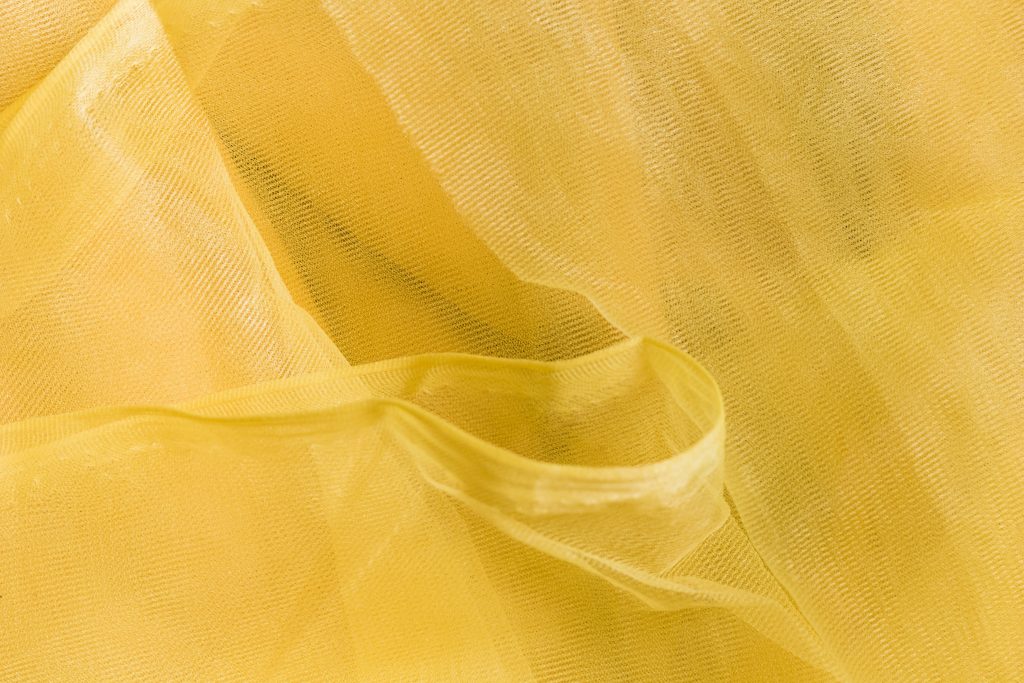
Organza is a very manageable fabric, owed to its featherlight quality, invigorating coolness, and inherent translucence. This fabric harmoniously accommodates both dyeing and intricate embroidery, be it within clothing collections or embellishing decor elements.
- Organza with Glitter: 93% Polyester / 7% Spandex
- Sparkle Organza: 100% Nylon
- Mirror Organza: 100% Polyester
- Embroidered Organza: 70% Polyamide / 30% Viscose
- Crystal Organza: 100% Polyamide
Oxford
Oxford fabric distinguishes itself with its gleaming finish, durability, and velvety texture, finding its primary application in the crafting of shirts.
While its usage has evolved to encompass various contexts, its initial introduction to the market was primarily within the realm of sportswear.
- Pinpoint: 100% Cotton
- Royal Oxford: 100% Cotton
- Polyester Oxford Waterproof: 100% Polyester
- Oxford Melange: 48% Polyester / 52% Viscose
Learn more: Get to know all about Oxford fabric and how to apply it in your collection
Percale
Percale is a sleek, delicate, and lightweight fabric boasting a refined surface. Typically crafted from pure cotton or blended with polyester, it embodies a smooth texture.
- Cotton Percale: 100% Cotton
- Mixed Percale 245: 61% Cotton / 39% Polyester
- Mixed Percale 250: 50% Cotton / 50% Polyester
Poly Viscose Fabric
A soft, comfortable, malleable fabric with a great fit. It is a mesh with good durability, being very resistant and fresh.
Also called, PV Fabric It is usually made from polyester, viscose, nylon, or spandex. These are synthetic materials that last a very long time.
- Poly Viscose: 33% Polyester / 67% Viscose
- PV Lycra Fabric: 55% Polyester / 18% Viscose
- PV Plush Fabric: 100% Polyester
Poplin
Highly versatile, poplin is lightweight, resistant to fraying, and offers exceptional thermal comfort to the body.
Typically, it’s a plain fabric made from cotton, silk, wool, synthetic fibers, or a blend of these.
This fabric finds application in a variety of products, including shirts, skirts, dresses, and overalls.
- Cotton Poplin: 100% Cotton
- Stretch Cotton Poplin: 97% Cotton / 3% Elastane
- Stretch Cotton Poplin (another type): 78% Cotton / 18% Polyamide / 4% Elastane
Satin
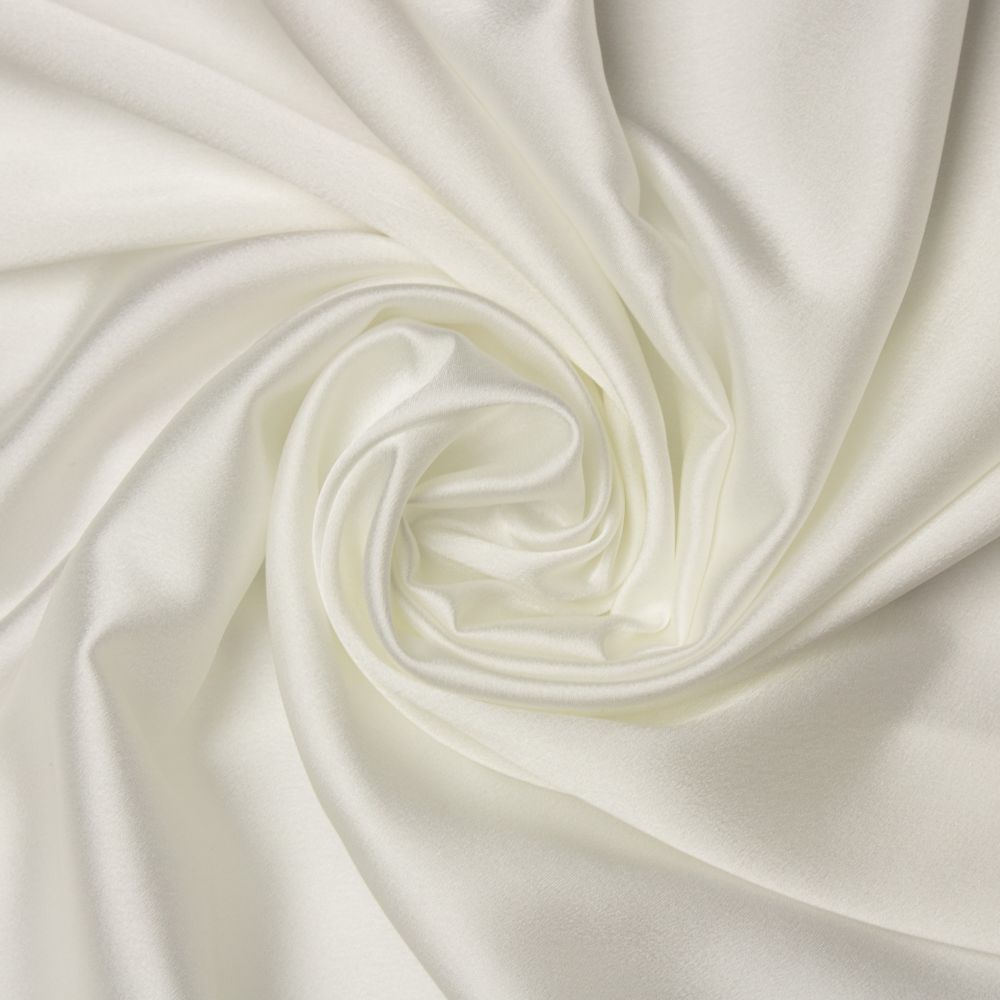
Satin has a lustrous appearance and minimal elasticity. However, certain variations of satin incorporate elastane into their composition, improving their flexibility.
Characterized by its lightweight nature, this fabric finds versatile applications in dresses, shirts, pajamas, and even lingerie.
- Acetate Satin: 100% Acetate
- Polyester Satin: 100% Polyester
- Silk Satin: 100% Silk
- Stretch Satin: Polyester or Silk with Elastane (Spandex or Lycra)
- Cotton Satin: 100% Natural Cotton
- Charmeuse Satin with Elastane: 97% Polyester / 3% Elastane
- Back Satin: Silk or Polyester
- Duchess Satin: Usually Polyester or Silk blend
- Slipper Satin: 100% Polyester
- Antique Satin, also known as Satin Back Shantung: 100% Polyester with a Shiny Satin and a dull matte side
- Crepe Back Satin: 100% Polyester fibers
Learn more: Learn all about satin fabric and how it can elevate your fashion production
Silk
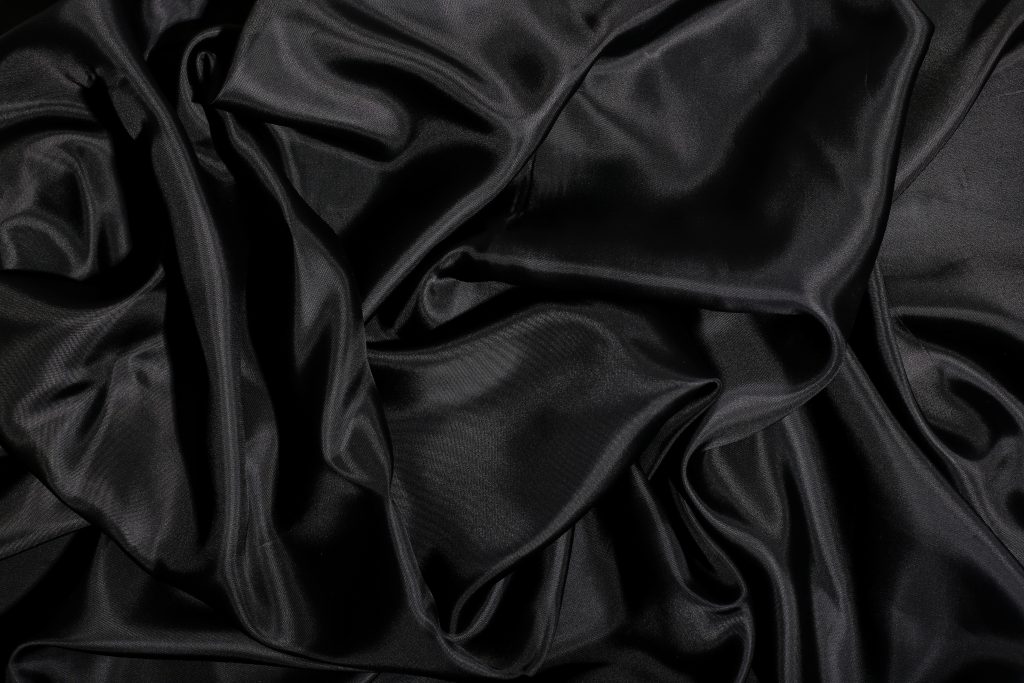
Silk is a luxurious fabric crafted from natural fibers sourced from the cocoons of silkworms.
With exceptional durability and exquisite softness, silk stands as one of the most sought-after materials.
Its impressive moisture-absorbing properties make silk a comfortable choice even on hotter days, offering a pleasing sensation against the skin by facilitating breathability.
Silk is available in a variety of forms, including:
- Silk Organza: 100% Silk
- Silk Taffetà: 64% Polyester / 36% Silk
- Silk/Linen Voile: 70% Silk / 30% Linen
- Silk Double Georgette: 100% Silk
- Silk Jacquard: 95% Silk / 5% Polyamide
Tactel
Tactel is a durable fabric known for its wrinkle-resistant nature and easy washability.
Also, it offers rapid drying capabilities and a pleasant tactile experience.
Tactel is engineered to provide a supremely gentle texture and a weight that’s at least 20% lighter than typical fibers.
- Tactel: 100% Polyamide
- Smooth Tactel: 100% Polyester
- Water Resistant Tactel: 100% Nylon
Taffeta
Taffeta can be crafted from silk, polyester, or acetate.
Its weave is notably textured, lacking a distinct backside, and its surface boasts a glossy finish.
- Taffeta Jacquard: 100% Polyester
- Silk Taffeta: 100% Silk
- Metalic Taffeta Lame: 100% Polyester
- Silk Shantung Taffeta: 100% Silk
Tergal
Tergal is a fabric recognized for its minimal moisture absorption, making it a popular choice for creating uniforms, linings, and aprons.
A form of polyester fabric that gained popularity during the 1960s and 1970s, tergal is known for its robustness and resistance to wrinkles.
A thermoplastic known under various trade names, Tergal is called like this in countries such, as France and Brazil. In Germany, it is called Trevira; and in the USA, Dacron. It is also known as Terylene.
- Fitted Tergal: 100% Polyester
- Tergal Jacquard Pattern Vintage: 100% Polyester
- Dacron Polyester/Cotton: 65% Dacron Polyester / 35% Combed Cotton Composition
Tulle
Tulle is a net-like lightweight fabric meticulously crafted from silk, cotton, or synthetic fibers, resulting in an exquisitely delicate and finely woven texture. Its ethereal nature is further enhanced by its thinness.
Notably endowed with a touch of elasticity, tulle serves as an ideal canvas for intricate embroidery.
- Tulle Fabric: 100% Polyamide
- Flocked Tulle: 100% Polyamide
- Embroidered Tulle Trim: 100% Nylon
- Viscose Silk Tulle: 80% Viscose / 20% Silk
Learn more: Get a closer look at tulle fabric and its top types for your collection
Twill
Twill fabric is distinguished by its primary attribute of softness, derived from its composition of pure or blended wool woven into diagonal lines.
This fabric finds extensive utility in crafting suits and uniforms. The most popular fibers used for twill are cotton and polyester, or a blend of both.
- Raw Twill: 100% Cotton
- Eco Twill: 97% Cotton / 3% Elastane
- Solid Twill: 94% Polyester / 6% Spandex
- Metallized Twill Colors: 75% Polyester / 15% Metal / 10% Polyamide
- Twill Cotton: 70% Cotton / 26% Polyester / 4% Elastane
Velvet
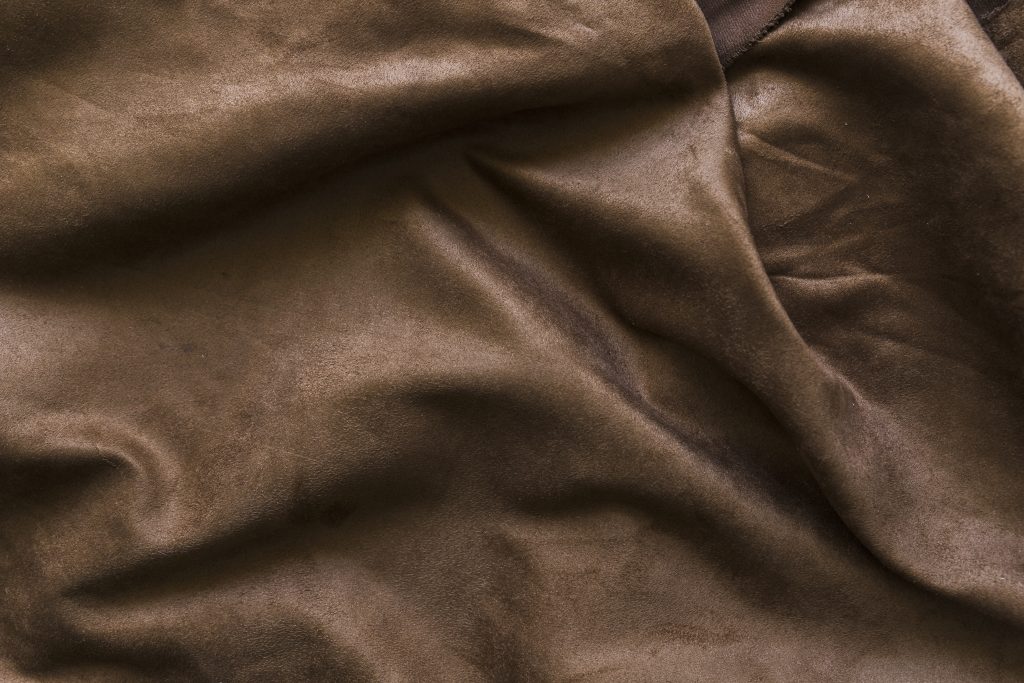
Velvet fabric has a plush and velvety texture attributed to the inclusion of natural fibers like silk, linen, and cotton in its composition.
- Plain Velvet Fabric: 82% Viscose / 18% Silk
- Velvet Jersey Knit: 85% Cotton / 15% Polyamide
- Cotton Velvet: 87% Cotton / 13% Elastane
- Stretch Velvet Fabric: 99% Cotton / 1% Elastane
Viscose
Also known as Rayon in the United States, Viscose is an artificial fiber. Viscose yarns are made from cellulose, which is taken from trees.
Viscose is known for being light and fresh, being widely used for summer pieces.
In addition, it is a type of fabric that absorbs moisture and dries easily, but wrinkles easily.
- Plain Viscose: 100% Viscose
- Viscose Lining: 51% Viscose / 49% Acetate
Voile
Voile is a fabric distinguished by its flat, textured, and semi-transparent weave. Moreover, it finds extensive application in the creation of summer clothing.
- Silk Voile Lamé: 57% Silk / 43% Polyester
- Silk Voile: 100% Silk
- Cotton Voile: 100% Cotton
- Chiffon Voile: 100% Polyester
- Viscose Voile: 100% Viscose
Enhance fashion creation with the perfect fabric selection using Audaces Idea

Developing a fashion collection requires meticulous fabric selection, a process that significantly impacts the precision of your creations.
Audaces Idea software stands as an invaluable tool to elevate your creative process, fostering agility and seamless communication during fashion creation.
Whether you’re striving for heightened precision or standardized workflows, Audaces Idea is your answer!
This innovative system facilitates the integration of design and tech pack development, empowering you to harness both creative vision and practical execution.
With the ability to incorporate print images and dynamically adjust their proportions on the fabric, your creative possibilities are boundless.
For further insights into the application of fabric composition and all types of fabric, download our free e-book today:
FAQ
A fabric composition chart is a summary containing details like fabric name, type, and the percentage of each fiber it comprises.
The fabric composition chart aids in minimizing production errors and enhancing overall product quality.
Fibers encompass natural, synthetic, and artificial classifications, forming the basis for various fabric types.






